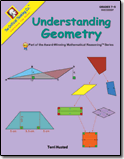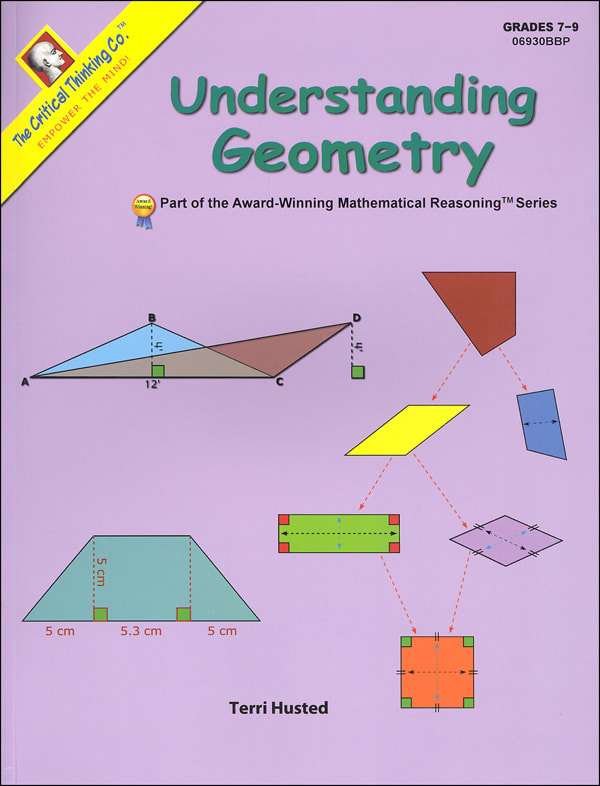Understanding Geometry is part of the Mathematical Reasoning series, but it differs significantly enough from the rest of the series to warrant its own review.
The Mathematical Reasoning series (for preK through sixth grade), along with some other elementary math programs, such as Singapore Math/Primary Mathematics, is quite advanced by the end of sixth grade. Rather than push students into algebra, the option selected here is to offer serious geometry for students who might be in grades seven through nine.
Understanding Geometry can be used in junior high as a one-year course or over two years if supplemented with other math learning. It might be used as a high school course but it does not go as far in depth as do most high school courses, and it does not include trigonometry. Nevertheless, it does teach all of the other key topics of a high school geometry course, including proofs—sufficient coverage for a high-school credit. An answer key is included at the back. (Note that the author's Understanding Pre-Algebra can also be used with students in grades six through eight, and these two courses together can serve as a bridge from Mathematical Reasoning G to any algebra 1 course.)
The author acknowledges that students might need “more exercises per topic.” Instruction is thorough but there are significantly fewer practice problems, no review problems, and no quizzes or tests. You can create additional worksheets for free at sites such as http://www.math-aids.com/Geometry/, but these worksheets and most I could find online for free are suitable only up through eighth grade. They do not provide practice for all concepts taught in this book. Books such as Mark Twain Media’s Geometry Practice workbook might be more useful as supplements. The limited number of practice problems and lack of assessment tools are the only negative issues I see with this course.
Before starting Understanding Geometry, students need to understand enough algebra to understand how to write and work with algebraic equations for lines. This is a math-based approach to geometry as is used in other high school level geometry courses (and in contrast to Key to Geometry which teaches concepts without mathematical computation.) Students use symbolic language and equations. If students have been adequately prepared with prior courses such as those in the Mathematical Reasoning series, they should have no problem. Coming from some other programs, students might need to have completed a seventh or eighth-grade level program before tackling Understanding Geometry. Sample pages can be viewed on the publisher’s website so you can judge whether or not a student is ready for the course. (click here)
Understanding Geometry sometimes uses inductive methods where students “discover” mathematical concepts through explorations, but it also uses direct instruction. Students are presented with some standard problems such as determining the volume of a cylinder. However, many problems ask students to explain their reasoning or describe a problem-solving strategy. Critical thinking is stressed throughout the course. In addition, students learn how to do geometric constructions with a compass and straightedge, a strategy that I think is especially helpful for understanding some geometry concepts.
Like the rest of the Mathematical Reasoning series, this worktext is printed in full color with many illustrations. A large font for the text and the limited amount of information per page make this much more manageable and unintimidating than most geometry courses.
I would recommend it for junior high students who want to get a jump on high school geometry and who will follow up with more intensive geometry later on. I would also recommend it for high school students who need a less-challenging option or for those who might even use it alongside another course. It might be a particularly good choice as a supplement for those using the classic Saxon series for high school math who want to cover more geometry earlier in the high school years.









